Isla Marisol, Gloverís Reef, BelizeContents of this Issue: Isla Marisol, Gloverís Reef, Belize Undercurrent Gets Grant for Coverage of Environmental Issues and Advocacy Divers Find the Last Slave Ship Raja Ampat, Bonaire, Maldives, Cozumel . . . After Drifting for Eight Hours, ďIím Just Glad Iím Alive Are Great Whites the Oceanís Most Fearsome Predators? New Findings Say No Can You Handle A Crisis Underwater? You Tell Us: Are You Prepared As You Should Be on a Dive? PADI Buys Americaís Two Biggest Dive Magazines Dump Valves, Customs Scams, Suunto Lawsuit Killed by Sharks While Snorkeling with Pigs Diving in Cuba is Harder for Americans Want to Buy a Dive Center or Liveaboard? Bahamas Master Cancels On Diver Twice In Two Years Why You May Be Experiencing ďOxygen EarĒ Editorial Office: Ben Davison Publisher and Editor Undercurrent 3020 Bridgeway, Suite 102 Sausalito, CA 94965 where divers are few, but the fish are plentiful from the July, 2019 issue of Undercurrent
Dear Fellow Diver: If you travel much, I'm sure you've had some airline nightmares. Like when the boat that will take you to an isolated, 18-acre Belize island makes only two scheduled trips a week, you don't want your flight to be late. Miss the boat, and it's a few hundred bucks to charter a ride.
Fortunately, it all worked out, and after a 10-minute Cessna flight south from Belize International Airport to the Dangriga airstrip on the central coast, I relaxed with a drink in beautiful February weather awaiting the boat departure for Glover's Atoll and Southwest Caye. I hoped the diving would be as good as Ben Davison, my editor, implied when he suggested I book with Isla Marisol to dive the least visited of the three Belize atolls, famed for good, uncrowded diving. The hourlong, 30-mile boat trip past the barrier reef to Southwest Caye arrived early enough for me to settle into my cabana, scope out the island and visit the bar for a pre-dinner Belikin Stout. My four friends and I, who came from Detroit and California, were the only divers, so there was no rush our first morning as we assembled gear and weights and got ready to dive. Captain Douglas and divemaster Mora were clearly experienced and promptly took charge. As with most sites here, the boat ride to Front Porch was about 10 minutes. I backrolled into the 80-degree water with 80-foot visibility (which decreased later in the week as the wind picked up). Most dives were on walls, but here I spent more time in the sand channels and along patch reefs. A turtle eased by, followed by a second one, which startled a diver as it passed right above her. I saw turtles on most dives, usually hawksbills. I suspect they're one of the few reef animals that are rebounding, as turtle-hunting has diminished in most areas of the Caribbean. The coral heads swarmed with bluehead wrasse and blue chromis. I poked around for small stuff, discovering three Peterson shrimp in one corkscrew anemone. No need to hurry -- we earlier had made a "go slow" request of Mora. Like at most sites here, barrel sponges were as big their namesakes. I've never seen so many whoppers; what causes variations like that on Caribbean reefs? And almost all of them had tiny sharp-nose puffers fluttering inside. I kept noticing blotchy black and white tiger groupers, almost devoid of their tiger stripes. They looked sickly, but actually, they were wearing their spawning colors. Must have been the season for love, because I saw many on several dives. After 45 minutes, as I rose to the safety stop, a southern ray kicked up sand below, while a fellow diver cupped her hands to corral a comb jelly. With the surface a little bumpy, I handed up my weights, took off my BC, tank and fins for the crew to pull up, and climbed aboard via the side ladder. Aside from the tigers, I didn't see many food-sized snappers or groupers on the first few dives. I -- and other tourists -- must bear some blame. On my first evening, I had a delicious dinner of grouper, with mac 'n cheese and green beans, and coconut cake for dessert. As the week went on, I did see decent numbers of Nassaus, tigers, and some big black groupers. Commercial fishing is not allowed near Glover's, but perhaps enforcement is not what it should be.
The dive dock is maybe a 100-meter walk across the palm-covered sands to a protected channel lined with mangroves. Paddleboards and kayaks were racked nearby in the same channel. With mangroves, I expected considerable sand flies, but my bites were few and mercifully short on itchiness. Each morning, I headed to the lodge early to get decent Belizean coffee and bring one back for my partner. By 7:15 a.m., I would return for a plain but hearty breakfast -- usually eggs with a meat, fresh tropical fruits, and juices -- and then get to the dock at 8 a.m. After the first dive, we usually returned for a short break. The afternoon dive was usually at 2 p.m., so by 3:45, I'd be at the dock rinsing my wetsuit, with plenty of downtime before cocktail hour. The over-water circular bar was the social hub for guests and staff, and the only place with Wi-Fi, albeit sketchy. On lucky days, I got Wi-Fi only at 6:30 a.m., so if you have work to do, you'll be in trouble. In the evenings, the bar was great for conversations. I often chatted with Mora, talking diving, Belizean politics, and history. Mora (full name Jaime Mora) worked with the American environmentalist Alan Rabinowitz nearly 40 years ago to establish the Jaguar Preserve (now Cockscomb Wildlife Preserve). Just buy a round or two and do some listening. Also, I brought several CDs, including one by Belize's most famous musician, Andy Pelacio. (Coals to Newcastle? Maybe, but it was a hit all around.)
The dive operation seemed solid. The crew hosed off gear daily, there's a shower on the dock, and the rental gear looked fine. My 1980s-era octopus started leaking, and Mora, unable to repair the antique, loaned me another. Both he and Douglas were helpful on the boat, where moving aft to backroll was necessary to avoid the Bimini top. These guys more than earned a generous tip. Mora, however, wasn't much of a creature scout, rather, focusing on big stuff like nurse sharks and barracuda that I can spot on my own. The open dive boat, maybe 25 feet long, was basic but roomy, with bench seating, and twin 210-HP engines steered from a console.
During the week, I only broke 80 feet on three of 17 dives. On my last dive, I headed toward the bottom of the wall at 120 feet (I skipped the Nitrox) and gradually moved up, unsuccessfully looking for black-cap basslets. At 60 feet, two green morays were snaking through cracks as they hunted. Mora says they eat lionfish; I heard the same on Roatan, but so far the scientific community says that while many fish will eat speared lionfish, none seem to prey on live fish.
With the location so remote, I didn't expect fancy food, but I wanted fresh and varied fare, and I got it. A typical dinner was pork chops and potatoes, eggplant, and fresh cake for dessert. One lunch was quesadillas with a good cabbage salad and the inevitable dessert. Meals were typically more Mexican than typical Belizean. The final meal of the week was a surprise to other guests, but not the divers. For several dives, Mora had mostly ignored the divers (there was no babysitting here) to hunt lobster, and that was our great last meal. Except for Cuba's Jardines de la Reina, Glover's Reef may be the best remote diving one can do in the Caribbean. Three years ago, I took a trip to Itza Resort on Lighthouse Atoll (see Undercurrent April 2016), which had great diving, even better than Glover's, because of the prolific reef sharks and occasional hammerhead there. But the resort has changed hands, and some reports have not been kind. Isla Marisol has a solid reputation and has been owned by the same Belizean family since it opened in 2002. If you like to dive where the gringos are few, the fish are abundant and the reef is healthy, this is the spot. -- M.A. Our Undercover Diver's Bio: "The author, along with his partner, has been diving and exploring the Caribbean and Central America for over 30 years, usually at away-from-themainstream locations. He says, "I've seen the huge impact of climate change on coral reefs over that period. It's a personal reason for taking political action."
|

I want to get all the stories! Tell me how I can become an Undercurrent Online Member and get online access to all the articles of Undercurrent as well as thousands of first hand reports on dive operations world-wide
| Home | Online Members Area | My Account |
Login
|
Join
|
| Travel Index |
Dive Resort & Liveaboard Reviews
|
Featured Reports
|
Recent
Issues
|
Back Issues
|
|
Dive Gear
Index
|
Health/Safety Index
|
Environment & Misc.
Index
|
Seasonal Planner
|
Blogs
|
Free Articles
|
Book Picks
|
News
|
|
Special Offers
|
RSS
|
FAQ
|
About Us
|
Contact Us
|
Links
|
3020 Bridgeway, Ste 102, Sausalito, Ca 94965
All rights reserved.

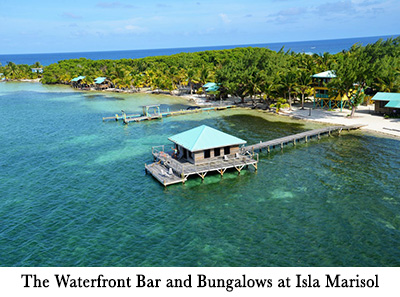 So I sat sweating at the San Francisco airport as
United kept pushing the departure time back, narrowing my
connection time in Miami to catch the flight to Belize.
Meanwhile, my partner, calm as always, read Lady with a
Spear, a memoir about the exploits and misadventures of
famed marine biologist Eugenie Clark.
So I sat sweating at the San Francisco airport as
United kept pushing the departure time back, narrowing my
connection time in Miami to catch the flight to Belize.
Meanwhile, my partner, calm as always, read Lady with a
Spear, a memoir about the exploits and misadventures of
famed marine biologist Eugenie Clark.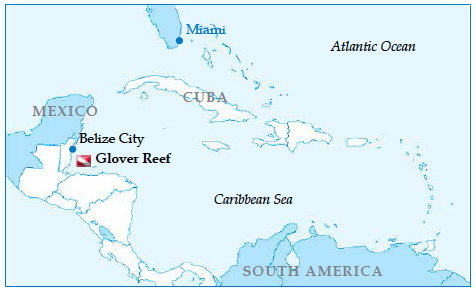 Isla Marisol occupies about half of Southwest Caye, with basic, traditional,
Belizean-screened cabanas on stilts stretching along the water. I had Cabana #1, near the
dining hall and the dock leading to the over-the-water circular bar. My pals, fearing
late-night noise, chose cabins farther down the beach, but this ain't no late-night party
place -- the bar emptied out by 9 p.m. -- and I liked the close run to fetch beer for
drinking while relaxing on our porch chairs. My cabana was roomy and comfy, with a front
porch facing the water from which I could watch shorebirds. I had two beds, a ceiling
fan, an open closet, a decent bathroom and shower with plenty of hot water, as well as
A/C, which I never ran in February. I could occasionally sniff a sewer odor, especially
when the wind died down. Because the island is barely a foot above sea level, you can
figure where the septic tanks sit. Some guests commented on it with wrinkled noses.
Isla Marisol occupies about half of Southwest Caye, with basic, traditional,
Belizean-screened cabanas on stilts stretching along the water. I had Cabana #1, near the
dining hall and the dock leading to the over-the-water circular bar. My pals, fearing
late-night noise, chose cabins farther down the beach, but this ain't no late-night party
place -- the bar emptied out by 9 p.m. -- and I liked the close run to fetch beer for
drinking while relaxing on our porch chairs. My cabana was roomy and comfy, with a front
porch facing the water from which I could watch shorebirds. I had two beds, a ceiling
fan, an open closet, a decent bathroom and shower with plenty of hot water, as well as
A/C, which I never ran in February. I could occasionally sniff a sewer odor, especially
when the wind died down. Because the island is barely a foot above sea level, you can
figure where the septic tanks sit. Some guests commented on it with wrinkled noses.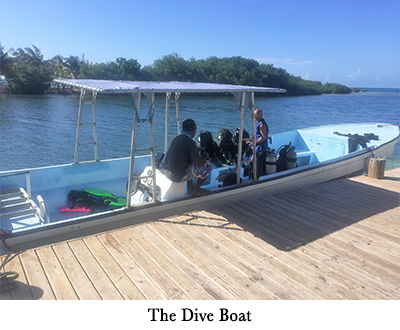 On day two at Midway Wall, I dropped
to the 45-foot bottom and stared at a
strange-looking sea cuke, a species I
didn't know, then cruised over the lip of
the wall. The wall bottomed out at 110
feet, but I eased along at 65 feet. Rainbow
runners swooshed by in the blue (Mora said
they were close to the reef for spawning
season). The abundance of reef fish grabbed my attention -- swarms of juvenile wrasses,
pretty yellow three-spot damsels, and a pair of butter hamlets. At other sites, I saw
indigo, barred, and butter hamlets, often in pairs. My partner found an inch-long slender
filefish on a sea fan. Mora woke up a six-foot nurse shark that swam within petting
distance. My partner pointed to her computer at 50 minutes, so we rose to 40 feet,
where spotted goatfish worked the sand, followed by a bar jack nabbing snacks. A unicorn
filefish floated overhead. On each dive, my friends and I checked out the coral cover;
Midway Wall was about 50 percent live coral, well above average for the Caribbean, as
global warming and ocean acidification continue to take their toll elsewhere. I was
heartened to see staghorn regrowing at several sites.
On day two at Midway Wall, I dropped
to the 45-foot bottom and stared at a
strange-looking sea cuke, a species I
didn't know, then cruised over the lip of
the wall. The wall bottomed out at 110
feet, but I eased along at 65 feet. Rainbow
runners swooshed by in the blue (Mora said
they were close to the reef for spawning
season). The abundance of reef fish grabbed my attention -- swarms of juvenile wrasses,
pretty yellow three-spot damsels, and a pair of butter hamlets. At other sites, I saw
indigo, barred, and butter hamlets, often in pairs. My partner found an inch-long slender
filefish on a sea fan. Mora woke up a six-foot nurse shark that swam within petting
distance. My partner pointed to her computer at 50 minutes, so we rose to 40 feet,
where spotted goatfish worked the sand, followed by a bar jack nabbing snacks. A unicorn
filefish floated overhead. On each dive, my friends and I checked out the coral cover;
Midway Wall was about 50 percent live coral, well above average for the Caribbean, as
global warming and ocean acidification continue to take their toll elsewhere. I was
heartened to see staghorn regrowing at several sites.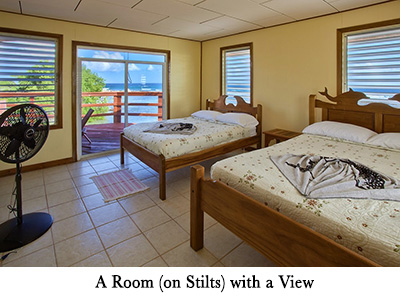 My favorite dives were off Long Caye,
a 20-minute boat ride, so lunch was picnicstyle
at the dock of Off the Wall Eco Resort,
a homey-looking, family-run operation. Long
Caye White Sands was a special site, with
Cozumel-like formations and swim-thrus weaving
between the wall and sands, alive with razorfish,
striped goatfish shadowed by porgies and
barjacks, garden eels swaying in the sand,
and critters worth a stop with my magnifying
glass. I counted a dozen solitary gorgonian
hydroids on one soft coral. A snoozing nurse
shark awoke to almost bump into my partner.
A Nassau grouper tucked himself tight under a
ledge. One diver took a pole spear to killand-
release lionfish, which led to a parade of queen triggerfish following along.
They seem to have an endless appetite for
speared lionfish. So do I, but none were
bagged for ceviche. Toward the end of the
dive, I spotted a huge terminal-phase blue
parrot, and a southern ray flew slowly
along, shadowed by two barracuda. By popular
demand, we went back to this site two
days later, where we encountered the only
significant current of the week, where
swimming over the sand was like tacking
into the wind.
My favorite dives were off Long Caye,
a 20-minute boat ride, so lunch was picnicstyle
at the dock of Off the Wall Eco Resort,
a homey-looking, family-run operation. Long
Caye White Sands was a special site, with
Cozumel-like formations and swim-thrus weaving
between the wall and sands, alive with razorfish,
striped goatfish shadowed by porgies and
barjacks, garden eels swaying in the sand,
and critters worth a stop with my magnifying
glass. I counted a dozen solitary gorgonian
hydroids on one soft coral. A snoozing nurse
shark awoke to almost bump into my partner.
A Nassau grouper tucked himself tight under a
ledge. One diver took a pole spear to killand-
release lionfish, which led to a parade of queen triggerfish following along.
They seem to have an endless appetite for
speared lionfish. So do I, but none were
bagged for ceviche. Toward the end of the
dive, I spotted a huge terminal-phase blue
parrot, and a southern ray flew slowly
along, shadowed by two barracuda. By popular
demand, we went back to this site two
days later, where we encountered the only
significant current of the week, where
swimming over the sand was like tacking
into the wind.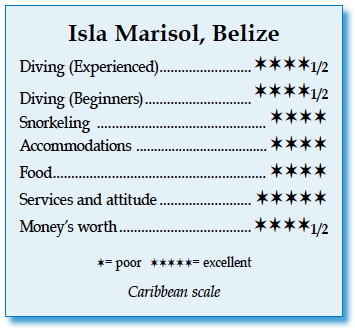 The mid-week boat from Dangriga brought 11 new guests (surprisingly, only snorkelers
and birders), ending my group's privacy. Southwest Caye is a good birding location,
with the forest sheltering songbirds and plenty of rich shallows for shorebirds. As for
snorkeling, I liked to edge along mangroves near the dive dock, where the channel was
covered with upside-down jellies. I reached better snorkeling by a short kayak paddle,
where I tied off to a buoy. For a couple of minutes, I joined an aggregation of goodsized
tarpon, which oddly included a barracuda.
The mid-week boat from Dangriga brought 11 new guests (surprisingly, only snorkelers
and birders), ending my group's privacy. Southwest Caye is a good birding location,
with the forest sheltering songbirds and plenty of rich shallows for shorebirds. As for
snorkeling, I liked to edge along mangroves near the dive dock, where the channel was
covered with upside-down jellies. I reached better snorkeling by a short kayak paddle,
where I tied off to a buoy. For a couple of minutes, I joined an aggregation of goodsized
tarpon, which oddly included a barracuda. Divers Compass: I paid $2,080, double occupancy, which was 10 percent
off the rack rate, for a week and 17 dives . . . I received free Nitrox
as a benefit for booking a group of five . . . I set my computer on air
for a safety margin, got to the red line on a few dives; aluminum 80s
were filled to 2800-3000 psi . . . I paid on-site via credit card for
my bar bill and I gave cash for a generous pooled tip, with an extra
tip for the boat crew . . . I exchanged several emails and phone calls
while planning the trip with Martha Usher, whose family owns the resort,
and she was helpful and cooperative . . . Isla Marisol's boat departs
Dangriga Saturday and Wednesday afternoons . . . The easiest way to get to Dangriga from
Belize International is via MayaAir or TropicAir . . . US$1 equals BZ$2; no need to
exchange currency unless you are visiting more remote areas . . . Dangriga is the gateway
to Cockscomb Wildlife Preserve and other natural treasures; Island Expeditions uses
the other end of Southwest Caye for adventures in paddle boarding, sailing, sea kayaking
and birding, and they have floored tents for accommodations . . . I also liked the
nice, family-owned Chaleanor Hotel, the tallest building in Dangriga. . . Websites: Isla Marisol -
Divers Compass: I paid $2,080, double occupancy, which was 10 percent
off the rack rate, for a week and 17 dives . . . I received free Nitrox
as a benefit for booking a group of five . . . I set my computer on air
for a safety margin, got to the red line on a few dives; aluminum 80s
were filled to 2800-3000 psi . . . I paid on-site via credit card for
my bar bill and I gave cash for a generous pooled tip, with an extra
tip for the boat crew . . . I exchanged several emails and phone calls
while planning the trip with Martha Usher, whose family owns the resort,
and she was helpful and cooperative . . . Isla Marisol's boat departs
Dangriga Saturday and Wednesday afternoons . . . The easiest way to get to Dangriga from
Belize International is via MayaAir or TropicAir . . . US$1 equals BZ$2; no need to
exchange currency unless you are visiting more remote areas . . . Dangriga is the gateway
to Cockscomb Wildlife Preserve and other natural treasures; Island Expeditions uses
the other end of Southwest Caye for adventures in paddle boarding, sailing, sea kayaking
and birding, and they have floored tents for accommodations . . . I also liked the
nice, family-owned Chaleanor Hotel, the tallest building in Dangriga. . . Websites: Isla Marisol - 